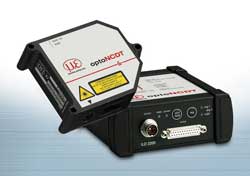
Posted to News on 20th Jun 2008, 15:03
Laser profile sensor ignores very small surface defects
A new non-contact laser profile displacement sensor is now available that uses a laser line and special software algorithms to filter out any interference caused by very small (sub-micrometre) surface defects on shiny objects such as polished metals, mild steel and rubber.

Rather than using a spherical or point-shaped laser spot, Micro-Epsilon's optoNCDT 2200-LL uses a special cylindrical lens that widens the laser spot. Although this widened spot appears as oval to the human eye, the actual shape is a very small line that measures just 30micrometres wide by 300micrometres in length. Measurements using this laser line are then averaged using Micro-Epsilon's patented software algorithms so that any interference caused by surface roughness, defects, indentations or holes down in the sub-micrometre range are filtered out.
The optoNCDT 2200-LL is therefore suitable for structured surfaces where the distance and not the structure itself needs to be measured. The distance measurement should not be influenced by the structure of the surface, but instead should provide a constant, reliable value of the distance from the target.
Erich Winkler, Product Manager at Micro-Epsilon, comments: "The speckle effect that is often associated with rough surfaces is filtered out by the new sensor's optics and software algorithms. A component with a rough surface, when illuminated with light from a laser, exhibits a speckled appearance. This effect makes it very difficult for laser sensors to measure distances to surfaces, especially if the surface defects are very small."
Applications
According to Winkler, the optoNCDT 2200-LL is already being used in a number of applications such as printing machines to measure the distance of lift cylinders and in textile machinery to measure the thickness of shiny, oily steel surfaces. The sensor is also being used to measure structured surfaces on grinding wheels and on CNC-turned parts, including shafts and tubes. Winkler explains: "These parts are cut from metal and are left with small machining tracks on the surface, which together act like a small mirror to a laser light. In this case, most of the light is reflected back to the sensor at different angles rather than in a diffuse manner and so the sensor struggles to take accurate measurements. The optoNCDT 2200-LL has been designed specifically to solve measurement problems such as these."
Seven different versions of the optoNCDT 2200-LL sensor are available, with measuring ranges between 2mm and 200mm. The sensor is based on the company's successful optoNCDT 2200 and therefore benefits from all the other advantages of this series such as fast measurement rates and automatic real-time exposure regulation.
For more information about Micro-Epsilon's non-contact laser displacement sensors and systems, go to www.micro-epsilon.co.uk/uk-en/Sensors/Optical---Laser/.
No. 1 Shorelines Building
Shore Road
CH41 1AU
UNITED KINGDOM
+44 (0)151 355 6070






























